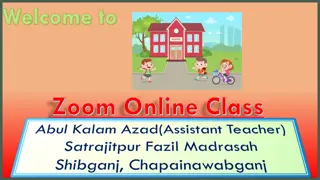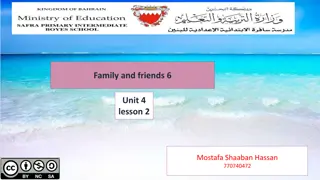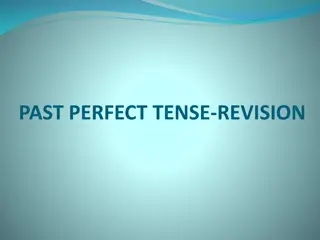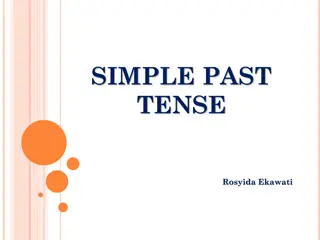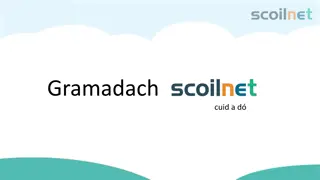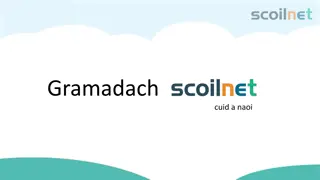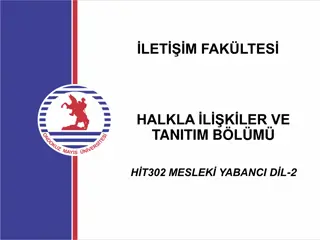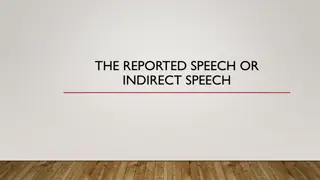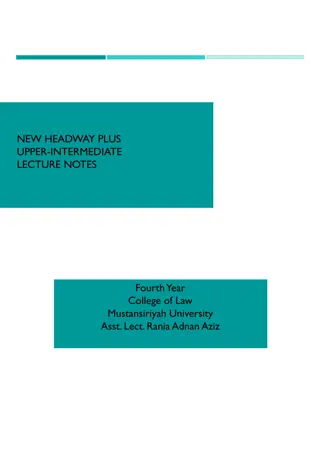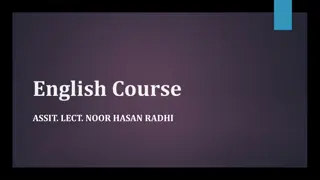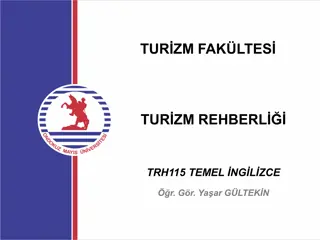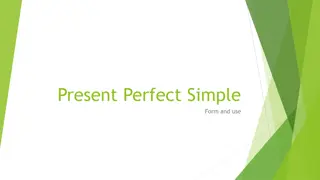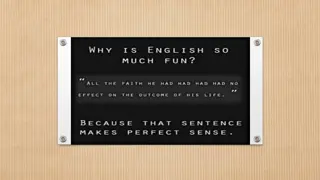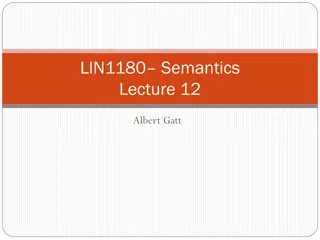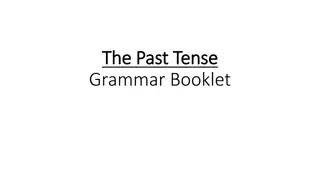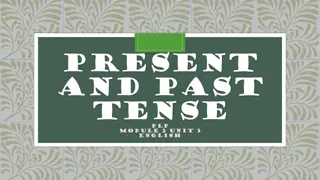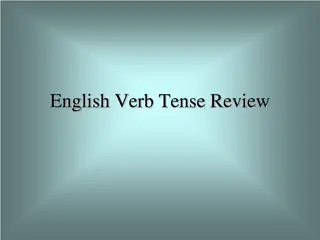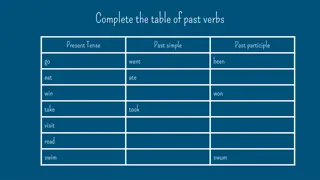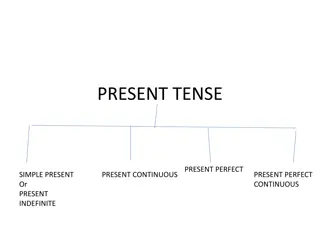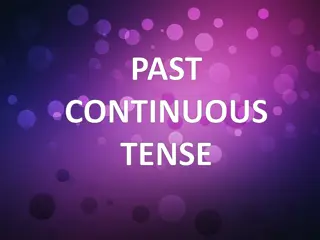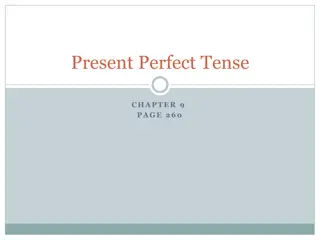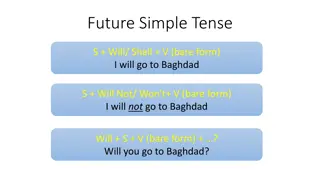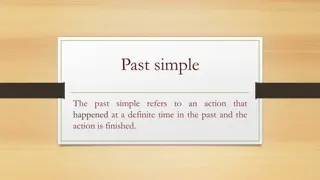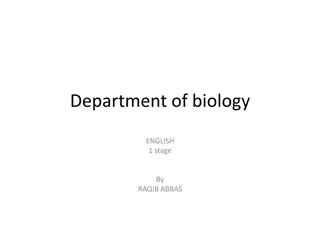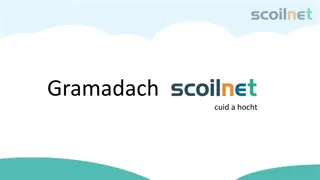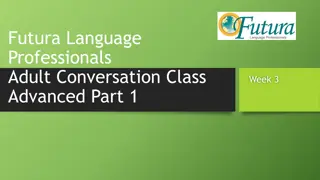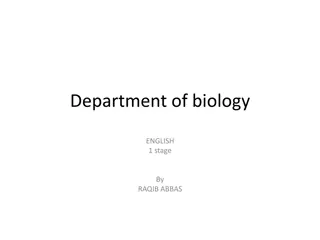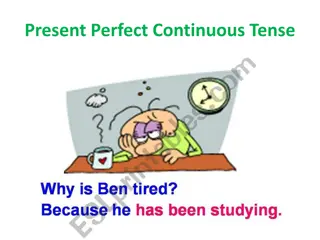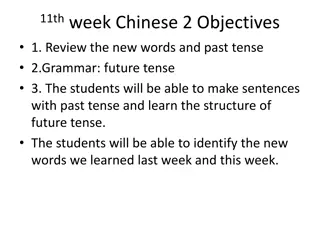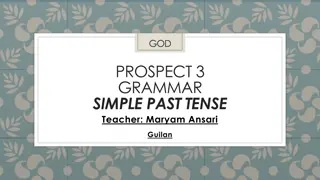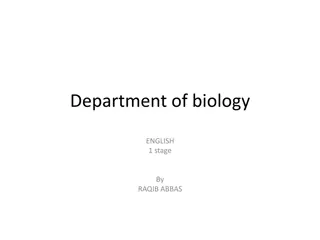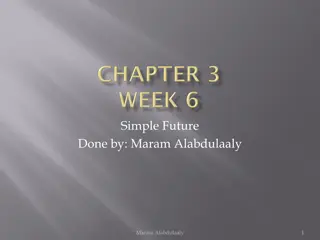Learn Past Continuous Tense - Grade 6 English Lesson
This Grade 6 English lesson focuses on understanding and correctly using the past continuous tense. It covers the rules for forming the past continuous tense, examples of its usage, and an assessment to test comprehension. Students will practice talking about actions happening at specific times in t
4 views • 6 slides
Learning Past Continuous Tense with Pronouns and Forming Questions
Explore how to use pronouns with "was" and "were" in the past continuous tense through examples and practice sentences. Learn to form questions using the past continuous tense and develop an understanding of when to use "was" or "were" with different subjects. Improve your grammar skills with this l
9 views • 15 slides
Understanding Tense in English Grammar
Explore the different types of tenses such as Present, Past, and Future Tense along with their classifications like Present Indefinite Tense, Past Continuous Tense, and Future Perfect Tense. Learn how to form positive and negative sentences in each tense with examples. Enhance your knowledge of Engl
2 views • 19 slides
Learning Future Simple Tense in English Lesson
Learn how to use the future simple tense correctly in English through a lesson focused on planning a trip to France. The lesson includes reading exercises, grammar rules, error correction practice, dialogues, and more to help you understand and apply the future simple tense effectively.
2 views • 7 slides
Mastering the Past Perfect Tense: A Comprehensive Guide
Explore the intricacies of the past perfect tense through engaging examples of two different events at different times in the past, understanding how to form sentences correctly and use time expressions effectively. Dive into exercises to enhance your grasp of the past perfect tense.
0 views • 10 slides
Understanding Simple Past Tense in English Grammar
Explore the usage of simple past tense through examples, irregular verbs, and regular verb forms. Learn how to form affirmative, negative, and question sentences in the past. Enhance your understanding of past actions and events with clear explanations and practice exercises.
1 views • 19 slides
Irish Grammar: Past Tense Verbs - Rules and Examples
Learn about forming the past tense of 1-syllable broad verbs in Irish grammar. Understand when to use "h," "d," or "dh" before verbs starting with consonants, vowels, or "f." Discover how to ask questions and form negatives in the past tense, with helpful examples provided.
0 views • 6 slides
Learning the Future Simple Tense with Regular Verbs in French
Explore how to form, recognize, and use the future simple tense in French for talking about your plans using regular verbs. Understand the differences between le futur proche and le futur simple and learn the endings for conjugating verbs in the future tense.
0 views • 8 slides
Understanding Irish Grammar: Past Tense Verbs and Questions
Delve into the intricacies of forming past tense verbs and asking questions in Irish grammar. Learn the rules for changing broad and slender verbs, both one and two syllables long. Discover how to form questions and negatives in the past tense, along with a quick recap of key points for easy referen
3 views • 5 slides
Examples of Passive Voice and Simple Present Tense in English
Explore various examples of passive voice and simple present tense usage in English sentences, including questions and statements with explanations. Understand how to form passive voice and identify simple present tense sentences through practical examples.
0 views • 15 slides
Mastering Reported Speech: Simple Present to Simple Past
Learn how to convert statements from the simple present tense to the simple past tense in reported speech with clear examples. Practice exercises are provided for better understanding, covering various sentence structures including negative sentences and present continuous to past continuous transfo
0 views • 45 slides
Understanding Regular and Irregular Verbs in Simple Past Tense
Learn how to form the simple past tense with regular and irregular verbs. Regular verbs end in "-ed," while irregular verbs have unique past tense forms. Examples and images illustrate the differences, helping you master past tense verb usage effortlessly.
0 views • 11 slides
Understanding the Present Perfect Tense in English Grammar
The lecture notes explore the Present Perfect tense, highlighting its connection between past actions and their relevance in the present. It compares the Past and Present Perfect tenses, discussing the nuanced differences and providing examples for clarity. The document covers the usage of the Prese
0 views • 8 slides
Understanding the Past Perfect Tense in English Grammar
The Past Perfect Tense is used to talk about actions completed before a certain point in the past, emphasizing the sequence of events. This tense follows the structure of "had + past participle" and is crucial for expressing events that happened earlier than others in a narrative. Knowing how to for
0 views • 27 slides
Understanding Simple Past Tense and Passive Voice Formation
The provided content covers the usage of simple past tense to discuss past events and the formation of passive voice in English grammar. Examples and explanations are given, along with vocabulary exercises and an apology scenario. Learn about making past verbs negative, forming passive sentences, an
0 views • 5 slides
Understanding Simple Past Tense in English: Rules and Examples
The simple past tense is a fundamental form in Modern English used to describe past events. It involves regular verbs adding "-ed" and irregular verbs having different forms. The construction of the simple past helps distinguish it from other past tense forms like past perfect and past progressive.
0 views • 33 slides
Understanding the Past Perfect Tense in English Grammar
The past perfect tense expresses actions that occurred before another action in the past, referring to time up to a point in the past. It is often used in reported speech and formal writing to indicate completed actions before a specific event. The past perfect progressive tense emphasizes the durat
0 views • 15 slides
Understanding the Present Perfect Simple Tense and Its Usage
Learn about the basic rules, formation, and usage of the Present Perfect Simple tense in English. Explore how to form the tense, use shortened forms, understand when to use "have" and "has" with past participles, differentiate between Present Perfect and Past Simple, know when to use the Present Per
0 views • 11 slides
Understanding English Tenses: Present, Past, and Future
Understanding tenses in English grammar is essential for effective communication. Tenses indicate the time of an action or event, such as present, past, or future. This article explores the different types of tenses, including present tense, past tense, and future tense, along with examples to help
0 views • 22 slides
Understanding the Present Perfect Tense in English Grammar
The present perfect tense in English grammar is a combination of the present tense and perfect aspect used to express past events with present consequences. It is formed using the auxiliary verb "have" and the past participle of the main verb. This tense is essential for indicating completed actions
0 views • 27 slides
Understanding Future Progressive Tense in English Grammar
Future Progressive Tense, also known as Future Continuous Tense, is used to indicate actions that will be ongoing at a specific point in the future. This tense emphasizes the continuous nature of an action happening in the future. Learn how to form and use the Future Progressive Tense through exampl
0 views • 22 slides
Understanding Tense and Grammatical Aspect in Language
This lecture delves into the intricacies of tense and grammatical aspect, exploring concepts such as progressive/non-progressive, perfective/imperfective aspects across languages. It discusses the interaction between grammatical aspect and lexical aspect (Aktionsart), focusing on tense as a deictic
0 views • 43 slides
Mastering the Past Tense: A Comprehensive Grammar Guide
Dive into the intricacies of forming the past tense in English with this detailed booklet. Learn the rules for regular verb conjugation, explore examples, and practice with engaging exercises. Sharpen your language skills and gain confidence in using the past tense accurately.
0 views • 10 slides
Understanding Present and Past Tense in English
Explore the differences between present and past tense in English through examples and explanations. Learn to distinguish these tenses, use idioms in conversation, and enhance your vocabulary. Practice exercises to reinforce your understanding. Discover the significance of past tense forms and how t
0 views • 9 slides
English Verb Tense Review: Simple Present and Simple Past
Simple Present Tense is used for habitual actions, unchanging truths, and general statements of fact. It is indicated by words like always, usually, and sometimes. Simple Past Tense is used for completed actions and past habits indicated by words such as yesterday and last night. The forms and indic
0 views • 46 slides
Learning Past Verbs and Present Perfect Tense
This content discusses past tense verbs through completing tables, giving examples, and exploring the present perfect simple tense with real-world scenarios. It covers verb conjugations in the past tense, such as went, ate, won, took, and swam, along with explanations and exercises related to the pr
1 views • 14 slides
Understanding Simple Present Tense and Its Usages
Simple Present Tense is used for habits, routines, and permanent truths. This tense follows a specific structure for positive, negative, and interrogative sentences. Through examples and exercises, learn how to correctly use Simple Present Tense in everyday conversations.
0 views • 8 slides
Understanding the Past Continuous Tense
The Past Continuous Tense is used to describe interrupted activities that continued for a period in the past or things happening continuously in the past. Learn how to form affirmative, interrogative, and negative sentences in this tense with examples and images.
0 views • 12 slides
Understanding the Present Perfect Tense - Chapter 9
The present perfect tense is used for actions or situations that occurred at an unspecified time in the past, repeated actions at unspecified times, ongoing actions from the past to the present, and more. Time expressions like "for" and "since" are essential in specifying durations and starting poin
0 views • 7 slides
Understanding Future Simple Tense in English Grammar
The Future Simple Tense in English is used to express decisions made at the moment of speaking, announce planned future events, show willingness or unwillingness for future actions, express thoughts, and talk about events certain to happen. It is often accompanied by adverbs to indicate timing. Ques
0 views • 11 slides
Understanding the Past Simple Tense in English Grammar
The past simple tense refers to actions that occurred at a specific time in the past and are now completed. This tense follows a specific rule where the subject is combined with a verb (regular or irregular) and a complement. Adverbs like "yesterday," "ago," and "last" are commonly used with past si
0 views • 9 slides
Understanding Past Simple Tense in English Grammar
The past simple tense is used to describe completed actions or events that happened at a specific time in the past. Regular verbs form the past simple by adding "-ed", while irregular verbs have unique past tense forms. The structure for negative and question forms involves the auxiliary verb "did".
0 views • 6 slides
Mastering Past Tense in Irish Grammar: 2-Syllable Broad Verbs
Understand the rules for forming the past tense with 2-syllable broad verbs in the Irish language, from identifying broad and slender verbs to asking questions and forming negative statements. Learn step-by-step processes and useful tips to enhance your grasp of the past tense.
0 views • 5 slides
Advanced Spanish Preterite Tense Irregular Verbs and Conjugations
Dive into advanced Spanish conversation with a focus on preterite tense irregular verbs and conjugations. Practice sentence translations, engage in conversation exercises using the preterite tense, learn new vocabulary, and review general notes for past tense usage in Spanish. Explore the conjugatio
0 views • 11 slides
Understanding Past Perfect Tense in English Grammar
Past Perfect Tense is used to denote actions that were completed before another action occurred in the past. It is formed using the auxiliary verb "had" followed by a past participle. Examples of affirmative, negative, and question forms are provided to illustrate usage. The tense helps in sequencin
0 views • 4 slides
Understanding the Present Perfect Continuous Tense
The Present Perfect Continuous Tense is used to emphasize the duration of an action that started in the past and continues up to the present, indicating ongoing actions with time expressions like 'for,' 'since,' 'all morning,' etc. Learn how to use this tense correctly and distinguish it from the Pr
1 views • 10 slides
Chinese Language Learning Objectives for 11th Week - Reviewing New Words and Future Tense
This instructional plan outlines the objectives for the 11th week of a Chinese language course. Students will review new vocabulary words and past tense, learn about the future tense, practice making sentences, and prepare for presentations. The content includes Monday's objectives, a review of new
0 views • 12 slides
Understanding Simple Past Tense in Grammar
In this file, we delve into the concept of simple past tense in grammar. Through examples and explanations, you will learn how to use the simple past tense to talk about completed actions in the past. The structure, usage, and importance of simple past tense are covered extensively to enhance your u
0 views • 30 slides
Understanding the Past Continuous Tense in English Grammar
Past Continuous Tense is used to describe ongoing actions in the past. It is formed with "was/were" + present participle (-ing). Learn its structure, usage, negation, and questioning forms with examples. Enhance your English grammar skills by mastering the Past Continuous Tense.
0 views • 4 slides
Understanding Simple Future Tense in English Grammar
Simple Future Tense is used to express actions that will happen in the future. It is formed using "will" or "be going to" and can also involve expressions like "shall." This tense is used for predictions, plans, willingness, and decisions made at the moment of speaking. Learn how to form affirmative
0 views • 20 slides


